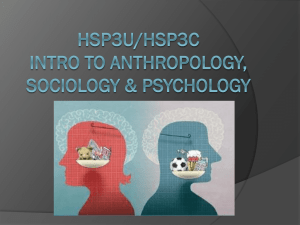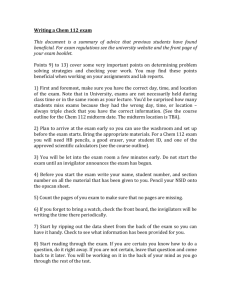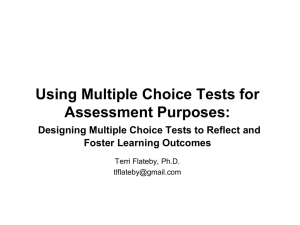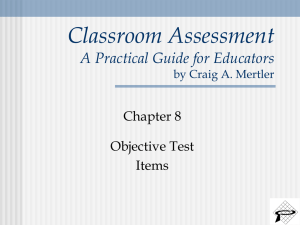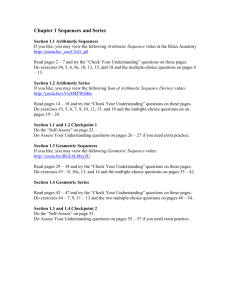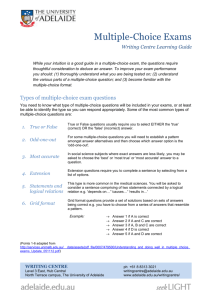A New Approach to Multiple-Choice Question Writing
advertisement
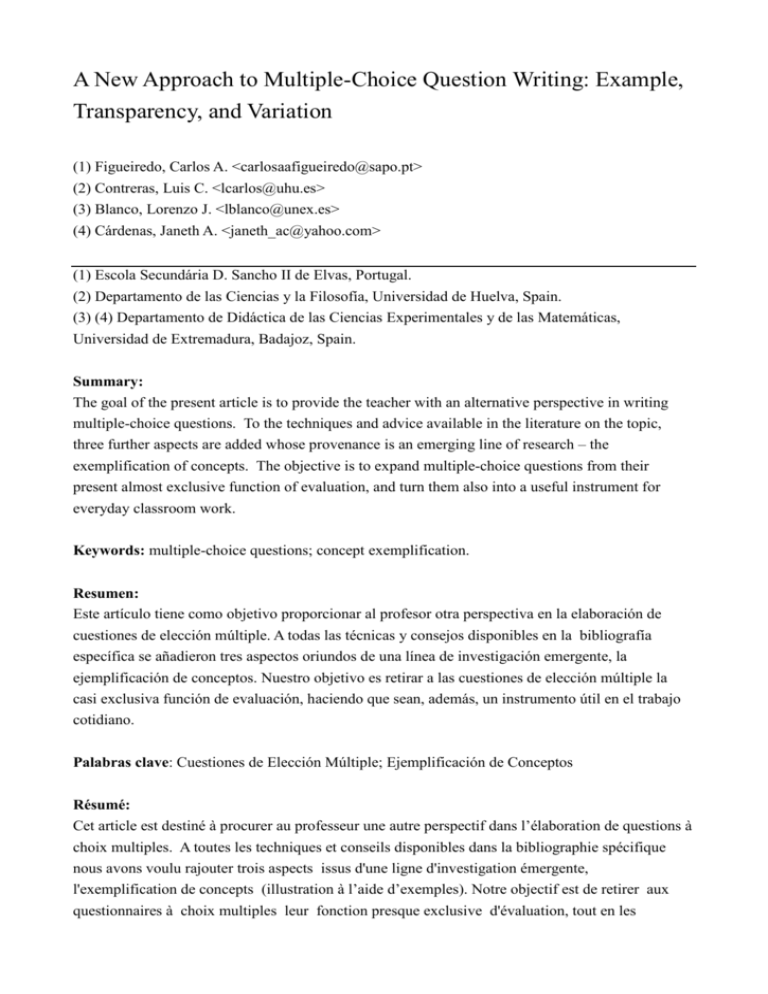
A New Approach to Multiple-Choice Question Writing: Example,
Transparency, and Variation
(1) Figueiredo, Carlos A. <carlosaafigueiredo@sapo.pt>
(2) Contreras, Luis C. <lcarlos@uhu.es>
(3) Blanco, Lorenzo J. <lblanco@unex.es>
(4) Cárdenas, Janeth A. <janeth_ac@yahoo.com>
(1) Escola Secundária D. Sancho II de Elvas, Portugal.
(2) Departamento de las Ciencias y la Filosofía, Universidad de Huelva, Spain.
(3) (4) Departamento de Didáctica de las Ciencias Experimentales y de las Matemáticas,
Universidad de Extremadura, Badajoz, Spain.
Summary:
The goal of the present article is to provide the teacher with an alternative perspective in writing
multiple-choice questions. To the techniques and advice available in the literature on the topic,
three further aspects are added whose provenance is an emerging line of research – the
exemplification of concepts. The objective is to expand multiple-choice questions from their
present almost exclusive function of evaluation, and turn them also into a useful instrument for
everyday classroom work.
Keywords: multiple-choice questions; concept exemplification.
Resumen:
Este artículo tiene como objetivo proporcionar al profesor otra perspectiva en la elaboración de
cuestiones de elección múltiple. A todas las técnicas y consejos disponibles en la bibliografía
específica se añadieron tres aspectos oriundos de una línea de investigación emergente, la
ejemplificación de conceptos. Nuestro objetivo es retirar a las cuestiones de elección múltiple la
casi exclusiva función de evaluación, haciendo que sean, además, un instrumento útil en el trabajo
cotidiano.
Palabras clave: Cuestiones de Elección Múltiple; Ejemplificación de Conceptos
Résumé:
Cet article est destiné à procurer au professeur une autre perspectif dans l’élaboration de questions à
choix multiples. A toutes les techniques et conseils disponibles dans la bibliographie spécifique
nous avons voulu rajouter trois aspects issus d'une ligne d'investigation émergente,
l'exemplification de concepts (illustration à l’aide d’exemples). Notre objectif est de retirer aux
questionnaires à choix multiples leur fonction presque exclusive d'évaluation, tout en les
transformant en un instrument de travail quotidien et utile.
Mots clés: Questions à Choix Multiples; Exemplification de Concepts
Introduction
Teachers, and especially mathematics teachers, frequently have recourse to using multiple-choice
questions (Kehoe, 1995). Even though we all make use of some basic set of guidelines, it is still not
easy to write this type of question if we want them to genuinely fulfil our intention (Kehoe, 1995;
Frary, 1995; Haladyna, Downing & Rodríguez, 2002). Writing examinations with items of this
nature is strongly oriented to the evaluation of knowledge or learning. Often these evaluations are
set by a teacher, but there are others implemented by the State itself. The quality of these
examinations depends in the first instance on the quality of each item. Hence, one of the most
important steps is writing this type of item (Haladyna & Downing, 1989a). But the use of multiplechoice questions is not exclusive to evaluation, although that is clearly its commonest area of
application. They may also be used in formative assessment situations or even in everyday class
work. As will be seen below, this kind of question, if constructed observing certain key aspects, has
a set of characteristics that show themselves to be important in teaching mathematics.
The aim of the present work is to present another perspective for writing multiple-choice questions
and to expand the scope of their use. The approach will be based on the interpretation of
exemplification, starting out from the notions of variation and of transparency of an example with
respect to a concept, which will be applied to transparent multiple-choice questions.
Thus, an analysis will be made of the twofold use that is made of multiple-choice questions as a tool
in everyday teaching activities and not just exclusively as an element of tests of evaluation.
1. Multiple-Choice Questions in the Literature
Before proceeding, we shall establish the terms commonly used in the literature on multiple-choice
questions. The 'stem' is the introductory question or incomplete statement at the beginning of each
item. It is followed by the 'options'. The options consist of the 'key' (the correct option) and
'distractors' which, although incorrect, are (it is hoped) tempting (Kehoe, 1995).
Numerous sets of guidelines for the quality construction of multiple-choice questions have been
published and are readily available in different specialist journals (see for example, Adams, 1992;
Haladyna & Downing, 1989a; Sireci, Wiley & Keller, 1998). Haladyna and Downing, (1989a,b)
reviewed 96 theoretical and empirical studies in which they identified 46 such guidelines. They
found that many of them had no theoretical base in any previous work, and therefore suggested that
there was a need for a study based on empirical or statistical data. Subsequently, Haladyna,
Downing and Rodríguez (2002) proposed a new list of 31 guidelines for good multiple-choice
question writing.
Many adults have at some time during their life responded to multiple-choice situations (Vacc,
Loesch & Lubik, 2001) – in school, job seeking, professional training, college, etc. Multiple-choice
questions are widely used and have a significant impact on the lives of the people who have to
answer them. This is the reason why the use of proven and effective techniques for their
construction is so important (Vacc, Loesch & Lubik, 2001; Haladyna, Downing & Rodríguez,
2002).
The popularity of these tests is the result of their various attractive characteristics. They can be
marked quickly, they are relatively precise, economic, and objective, and they can be applied to a
great variety of topics (Cohen & Swerdlik, 1999). Also, they can be targeted at different levels:
according to Vacc, Loesch and Lubik (2001), multiple-choice questions can evaluate different
cognitive functions – memorization, application, and analysis.
With respect to the guidelines put forward by different researchers, while there is agreement on
many, there are others that are not universally accepted. Since the goal of the present work is not
exhaustivity on this point, a restriction will be made to noting only some of those about which there
is full agreement in the literature, following Haladyna, Downing and Rodríguez, (2002):
Guidelines for multiple-choice question writing
Writing stems:
1.
2.
3.
4.
5.
Use clear, simple language.
Present a single idea or problem.
Include most of the words and as much information as possible so as to avoid long
Avoid expressions in the negative.
Avoid stereotyped phrases.
options.
Writing options:
6.
7.
8.
9.
Take care to avoid including irrelevant information.
The options must be mutually independent.
Avoid the use of "all of the above" and take great care with the use of "none of the above".
The distractors must be appealing to those students who have not mastered the content given in
the stem.
10. Good distractors are comparable in length, complexity, and grammatical form to the key.
11. Avoid distractors that contradict each other.
12. Avoid providing cues that point to the key.
The overwhelming use of multiple-choice questions is for evaluation. All of the literature that we
have consulted points to that (almost) exclusive use – i.e. as items of a test. In textbooks, however,
their use is also presented as an exercise. In the present article, different situations will be
considered which are suited to the use of multiple-choice questions, particularly in classwork and in
formative assessments.
2. The Example
It has long been recognized that students learn mathematics more by contact with examples than
through formal definitions. It is with examples that the definitions take on meaning (Watson &
Mason, 2002).
Consider the following infinite sequences of numbers:
A:
2, 4, 6, 8, 10,…
B:
1 4 7 10 13
, , , , ,…
3 3 3 3 3
C:
D:
5, 2 5,3 5, 4 5,5 5 …
-2, -2, -2, -2, -2,…
One could take each of these sequences to be an example, but one could also take all of them
together to be a single example consisting of four sequences. Let us suppose that one of the
following texts is presented before the presentation of the sequences:
E1. After analyzing the four sequences A:, B:, C: and D:, indicate what for you they have in
common.
or
E2. For each of the following arithmetic progressions, indicate the value of its common
difference.
or
E3. There exist arithmetic progressions whose common difference is not rational. Indicate
an example of that in one of the following progressions:
Thus the same situation – an example consisting of four sequences – has three very different uses.
The first is a case of a particularization that presents a basis for a generality. The aim is for the
students to generalize a characteristic that is common to four elements in order to construct a
definition of Arithmetic Progression. This example thus materializes a concept, i.e., it in some form
personifies the characteristic that is general and generalizable. The example would have an
inductive use (Rowland & Zaslavsky, 2005). If one wanted, one could have opted for the opposite
sense: first introducing the definition of Arithmetic Progression to see immediately the different
materializations of the concept thus defined. The example would then have a deductive use
(Rowland, Thwaites, & Huckstep, 2003).
In the second, the example could serve as an illustration or as a practical activity, aimed at the
student developing skill in a given process or technique (Sangwin, 2004). Being an activity that is
based on calculating differences, the aim might seem only to be to check that indeed these are four
arithmetic progressions. But clearly the intention may also be for the pupils to make contact with
different kinds of progression.
The third could easily be one of a set of items constituting an examination. With a question like
this, the teacher's intention is only to determine whether the pupil knows how to distinguish
between rational and irrational terms in the field of progressions. I.e., it is a question designed to
indicate whether the pupil knows how to give a correct response concerning a particular topic.
2.1. Three distinctions and three characteristics
For this article, we propose a classification into the categories obtained from the three situations in
E1–3 above. Depending on the purpose for which it is used, the same example can be:
A particularization (obtained from E1) if it is presented on the one hand after a definition in
order to embody that definition in a deductive process, or on the other before the definition as
part of an inductive process. Both processes, however, are aimed at the generalization of the
concept being defined.
A problem or an exercise (obtained from E2) according to whether it is oriented to practice or to
the development of skill in some technique or process (Watson & Mason, 2002).
One item (obtained from E3) of a series of items which together constitute an instance of
evaluation.
Figure 1: Classes of examples.
For Bills et al. (2006, p. 135), independently of what distinctions and classifications might be made
of examples, there is one characteristic that they all ought to have – utility. An example is useful if
it is transparent and generalizing:
Transparency, making it relatively easy to direct the attention of the target audience to the
features that make it exemplary. This notion will be returned to below in Section 4.1.
Generalizability, the scope for generalisation afforded by the example or set of examples, in
terms of what is necessary to be an example, and what is arbitrary and changeable.
For those authors, the teacher's role is to present favourable circumstances for learning that involve
a great variety of "useful examples" (without overwhelming the learner which could instead lead to
confusion) targeted at the students' needs and characteristics.
2.2. Examples, non-examples, and counter-examples
An example is to be understood as a general situation referring to a concept or a definition. Some
authors classify examples by their nature (Bills et al., 2006), others by their use, function, or
objective (Rissland-Michener, 1978; Figueiredo, 2005; Figueiredo, Blanco & Contreras, 2006). In
the following some cases involving three themes of secondary education mathematics are presented
in order to illustrate and add meaning to the content of the study. Clearly, of course, one can find
similar situations in most of the content of the different levels of mathematics teaching.
Hence, from the following definition
Definition 1: A Sequence of Real Numbers is any application of in .
we could present the examples
Examples: an 3n2 2 ; bn
1
1
; cn n
n
2n 1
A non-example serves to define the limits of a concept, or of a case in which a procedure is not
applied or fails to give the desired result, or to demonstrate that the conditions of a theorem are
precise and well defined (Bills et al., 2006). They are cases that, while close to the example, are not
themselves examples because they violate some rule inherent in the definition.
Thus, with respect to Definition 1, one has the non-example
Non-example: en
1
2n 10
which is not a sequence because the term is not defined for n = 5.
Now let us consider another definition:
Definition 2: A term of the sequence an
n
is any real number that it is obtained from
n 1
specifying a value of n in the general term an .
In this case, one could present the non-example
Non-example:
5
5 1
because the value given to n was not a natural number, as required in Definition 1.
Counter-examples are familiar to us all as being used to demonstrate that certain arguments or
statements are false. They are used to bring out the differences between concepts or to define their
limits well (Rissland-Michener, 1978; Zaslavsky & Ron, 1998).
These cases are examples because they are mathematical objects that satisfy all the initial
characteristics present in the statement, but they do not have the additional characteristic or
characteristics that the statement attributes to them.
Take the following (false) statement in Plane Geometry:
Statement: Every quadrilateral with perpendicular and equal length diagonals is a square.
Counter-example:
This argument is a mathematical object which, while verifying the characteristics present in the
antecedent, does not necessarily have the characteristics ascribed to it by the consequent. This is
also the case of the following (false) argument:
Argument: Since 18, 36, and 72 are both multiples of 9 and multiples of 6, then all
multiples of 9 are also multiples of 6.
Counter-example: 27.
3. Dimensions of Possible Variation and Range of Permissible Change
People's attention is naturally drawn to noticing variations in an otherwise invariant context. It is
intuitive to conclude therefore that students will not understand some important aspects of the
material presented to them or given them as exercises to work on if there is little or no variation
present. If the students are going to experience variation and, moreover, to learn from it, then there
must be variation at a sufficient rate for it to come to their attention (Mason & Watson, 2005).
Marton and Booth (1997) developed the notion of learning as discernment, i.e., the recognition that
one only becomes aware of something when there exists variation (where nothing varies, no
distinction is possible). Thus:
To learn is to understand the possible variations that we had not been aware of previously
(Mason & Watson, 2005).
Dimensions of Possible Variation: In order to appreciate a concept in mathematics, it is essential
to be at least subliminally aware of what is exemplary about a given example – what aspects, what
dimensions can change and still the example remain an example of the concept (Mason & Watson,
2005).
Range of Permissible Change: Hand in hand with each dimension of possible variation there is the
range of its permissible change. The Permissible Amplitudes of Change must reflect any limitations
on the nature and extent of the changes that are permitted. In identifying the dimensions of possible
variation which make a concept what it is, it is important to remember that one of the reasons for
using the words possible and permissible is to draw attention to the fact that there may be
significant differences between students and teachers in the scope of what they are aware of, and
this may in turn differ from mathematical convention or canon (Mason & Watson, 2005).
The awareness of a dimension of possible variation is essentially awareness (perception) of
generality. Put another way, awareness of the dimension of possible variation is essential for
people's example spaces to be richly representative of concepts. Learning a concept in mathematics
requires awareness of what aspects, features, relationships, or properties are invariant while at the
same time other major features or aspects are allowed to vary (Mason, 2005).
Since it is unreasonable to expect every student to reconstruct every possible dimension of variation
for themselves, even with the assistance of carefully written, schematically constructed exercises, it
is of major advantage to learners if their teachers are themselves aware of the various dimensions of
possible variation (Mason & Watson, 2005).
The use of examples in the classroom is an essential, and always complex, field. It involves careful
selection of specific examples to facilitate attracting the students' attention appropriately, as well as
explaining and inducing generalizations (Bills et al., 2006).
4. A Different Approach to Multiple-Choice Question Writing
Accepting that evaluation is the aspect most extensively dealt with in the literature on multiplechoice questions, we shall now consider in greater depth their introduction into the teachinglearning context by using techniques of exemplification.
Figure 2: The role of multiple-choice questions
The exemplification provided to the students must be rich and varied (Bills et al., 2006). But it must
be presented as a series of examples (Mason & Watson, 2005; Sangwin, 2004) which either offer
variation that is perceptible to students (Bills et al., 2006) and allows them to extend their personal
example spaces (Watson & Mason, 2002; Bills et al., 2006), or maintain an invariance that allows
them to induce a generality (Watson & Mason, 2002; Mason, 2005; Bills et al., 2006).
It is in this regard that the multiple-choice example is particularly well-suited since its set of options
contain both the variation and the invariance. Thus, the student has the opportunity to form the
structure of the concept being studied, whether by abstraction or by defining its boundaries. To
learn is to extend example spaces – to add examples to those that are already well known so that
concepts can be reconstructed and restructured (Watson & Mason, 2002; Bills et al., 2006). This can
easily be done in a multiple-choice context in which each item has 3, 4, or more options (answers).
Each option must correspond to a dimension of possible variation, and the logical value of the
statement contained in the key (the correct answer) must lie within the bounds of the range of
permissible change – going outside that range generates non-examples or wrong answers. The nonexamples, by staying close to the example and thus appearing plausible, give a false idea of
veracity, as recommended in Guideline No. 9 (Section 1).
If the stem of the multiple-choice item is in the form of a statement, each rejection of some
distractor may involve the use of a counter-example, or perhaps the identification of a non-example.
But only those students who have developed a correct structure of the concept will manage to do
this.
4.1. Transparent examples
As was seen in Section 2.1, an example is transparent if it allows the student to see its essential
aspects that make it a paradigm of a concept.
The transparency of an example may be at the base of what Mason and Pimm (1984) call a Generic
Example or Rissland-Michener (1978) call a Reference Example. They are examples which the
teacher considers to be paradigms of a certain concept, i.e., general cases that represent an entire
class of examples which have the same purpose – to illustrate a given concept.
Let us consider the expression f ( x) a( x h)2 k which is a way of representing a second-order
polynomial function (if a 0 ) whose graph is a parabola. We can obtain f ( x) by applying the
three transformations of the plane to g ( x) x 2 , and, if the vertex of the parabola defined by g ( x)
has the coordinates V(0,0), then the vertex of f ( x) is the point of coordinates V(h,k). Assuming
that the student understood the steps indicated, then the expression f ( x) a( x h)2 k is a
generality that admits the particularization h( x) ( x 2)2 5 whose associated parabola has its
vertex at the point of coordinates V (2, 5) Observe that the example is transparent with respect to
the concept of the graph of a parabola of known vertex.
The programs of Mathematics-A in Portugal (years 10–12 of schooling) include many expressions
that are transparent with respect to certain concepts:
( x 1)2 ( y 5)2 62 is transparent with respect to the coordinates of the centre and the radius
of the circumference that it defines, but x2 y 2 4 x 2 y 6 0 is not.
x 1
is transparent with respect to its horizontal asymptote because, having studied the
x2 4
limits of real functions of a real variable, the students see that the degree of the numerator is less
than that of the denominator, and know that in such cases the limits at are zero, and hence
that y 0 is the function's horizontal asymptote.
f ( x)
| z i || z (2 i) | is transparent with respect to the closed semiplane that includes i and is
bounded by the straight line that is the mediatrix of the straight-line segment [i; 2 i] in an
Argand diagram.
The characteristics of transparent examples do not by themselves provide the results we want. The
principal outlines, subtleties, and limits, and the connections between them will not be constructed
by the student by our simply presenting him or her with transparent examples. For instance, the two
sides who are the actors in the teaching-learning process do not interpret the examples in the same
way. For the teacher, a certain example may play the role of a paradigm while, for the student, it is
just another case to learn (Mason & Pimm, 1984). It is the teacher's job to be on the lookout for this
difference in perspective so as to empower the use of examples, and to make it clear why they are
important and what their function is supposed to be. In other words, the features of this type of
example that make them paradigms from the teacher's perspective can pass completely unnoticed
for the students. If this is the case, the goal of the planned presentation would be totally missed, and
the student would get no benefit at all from the fundamental purpose of the example that the teacher
presented. How and to what degree an example may be transparent is very subjective (Bills et al.,
2006). The class atmosphere, the content, and how the teacher presents the examples and their most
outstanding characteristics, can make the difference between an example that is well understood and
useful and one that is just another example.
4.2. Dimensions of possible variation, range of permissible change, non-examples, and counterexamples
Consider again the example f ( x) a( x h)2 k . Observe that the letters a, h, k refer, respectively,
to the sense of its convexity and the possible contraction or expansion of the graph, to a horizontal
translation, and to a vertical translation. These three letters indicate the three dimensions of
possible variation in this example, and the ranges of permissible change are in the case of h and
k, but \{0} in the case of a. In the case of a=0, we would be in the presence of a non-example.
Now let us again consider Definition 1 (Section 2.2): A Sequence of Real Numbers is any
application of in . As was seen above, un
n
is a particularization of this concept, but
n 1
n
is a non-example because the term is not defined for n = 5. Observe that in this case the
n5
dimension of variation does not correspond to a numerical element of the expression, but to an
operational element. The range of permissible change does not include all four basic operations. If
vn
the use of the operation "-" gave rise to a non-example, the use of the operations "+", "×", and "÷"
would give rise to another three particularities.
x 1
, one is introducing a dimension of possible
x2 a
variation when with the parameter a. The range of permissible change is the entire set of real
In the example of a rational function f ( x)
x 1
were presented to illustrate the existence of vertical
x2 a
asymptotes, the parameter a would continue to be one of the dimensions of possible variation, the
numbers. But if this example f ( x)
range of permissible change would only be the negative real numbers for the existence of two
vertical asymptotes, and the variation would be reduced to a single value, zero, for the existence of
only one vertical asymptote.
Suppose that one states that for all a in there exist vertical asymptotes for f ( x)
x 1
, using
x2 a
this example because of its transparency with respect to this concept. Then the value a=3 would
constitute a counter-example, since x 2 3 has no real roots.
It is thus clear how adaptable the "multiple-choice" genre is when the aim is to explore the
transparency, the dimensions of possible variation, the range of permissible change, and the nonexamples and counter-examples of appropriate options for the concept indicated in the stem of the
item.
STEM OF THE ITEM:
TRANSPARENT EXAMPLE
OPTIONS:
KEY or DISTRACTORS:
1st
1st DIMENSION OF VARIATION or 1st NON-EXAMPLE
2nd
2nd DIMENSION OF VARIATION or 2nd NON-EXAMPLE
3rd
3rd DIMENSION OF VARIATION or 3rd NON-EXAMPLE
4th
4th DIMENSION OF VARIATION or 4th NON-EXAMPLE
N.B. One of the options would have to be the key, and the other three, distractors.
4.3. A practical case
It would make no sense to write the present work without including a multiple-choice item that
follows the guidelines presented in Section 1 and the suggestions put forward in the subsequent
sections.
The following multiple-choice item might serve as an exercise or as a test item:
“”
Consider the graphs of the functions f and g below.
Graph of the function f
If the function h is defined by h
Graph of the function g
f
, one can affirm that:
g
A
The roots of h are x=0 and x=4.
B
The sign of h is positive in ]-2,0[.
C
The domain of h is \{0,4}.
D
lim h( x) .
x 0
“”
A check of this multiple-choice question against the guidelines presented in Section 1 shows that it
satisfies each of the twelve points.
With respect to the dimensions of possible variation and the respective ranges of permissible
change, one first observes that each option includes a different dimension. Given the form in which
the function h is presented, the question is transparent with respect to the concepts of root, sign,
domain, and limit at a point. The ranges of permissible change are easily identifiable. In the first
dimension, the range is , but the use of any value other than -2 and 2 will generate counterexamples with respect to the roots of h. In the second dimension, the range is manifest in the form
of intervals; in the third, it is in terms of the zeros of the denominator; and, in the fourth, in the form
of the signs used in the quotient.
5. When the Stem is Not Transparent with Respect to the Options
Consider an instance of one of the previous examples: f ( x) 3( x 2)2 1 . If the stem of the
exercise or item asks which are the coordinates of the vertex, then the student who has mastered this
topic will have no difficulty in replying immediately and correctly. But if we used the example
f ( x) x 2 4 x 6 in this exercise or item, even the students who would have had no problem in
responding to the previous situation would no longer be able to reply immediately. Possibly, the
reason is the second example's non-transparency with respect to the coordinates of the vertex. The
students will need to have recourse to calculation or a graphical calculator to answer. Perhaps they
need to have or to develop that skill, but to evaluate or practise it a multiple-choice example might
not be the most advisable. This suggestion is possibly extendable to proofs and problem solving.
While in the specific case of mathematics, calculation, problem solving, and mathematical proof are
areas in which exemplification in the form of multiple-choice may not be the most appropriate, we
are convinced that multiple-choice examples are well suited to use in situations where answers are
immediate, with no calculation or written output.
6. In Synthesis
From the perspective of evaluation, there is ample literature on multiple-choice tests. Nevertheless,
the process of teaching-learning on the basis of the use of transparent examples with an appreciable
variation, in which the dimensions of possible variation are worked on with a view to extending the
learners' personal example spaces is an emerging topic.
The intention with this work has been to bring everything together in the concept of a transparent
multiple-choice item, a perspective from which it will be possible to give a new slant to
constructing this type of example. We believe that the concept of transparent multiple-choice item
may constitute an interesting and useful guideline for a teacher to follow in writing multiple-choice
items, whether they are to be used as test questions or as exercises and particularizations of the
concepts being taught. In everyday teaching activities, the role of this instrument has been almost
exclusively oriented to evaluation. In our judgement, it is possible to also transfer its use to the
everyday teaching-learning context, and hence give it this twofold functionality of sometimes being
used as a particularization or as exercises, and at other times being used as an evaluation tool.
References
Adams, R. (1992). Multiple-Choice Item Writing: Art and Science. The Bar Examiner. 5-14.
Bills, L., Dreyfus, T., Mason, J., Tsamir, P., Watson, A. & Zaslavsky, O. (2006). Exemplification
in Mathematics Education. In J. Novotna (Ed.), Proceedings of the 30th Conference of the
International Group for the Psychology of Mathematics Education. Prague, Czech Republic: PME,
1, 126-154.
Cohen, R. J. & Swerdlik, M. E. (1999). Psychological Testing and Assessment: An Introduction to
Tests and Measurement (4th ed.). Mountain View, CA: Mayfield.
Figueiredo, C. A., Blanco, L. J., Contreras, L. C. (2006). Los Ejemplos utilizados por los
profesores en la enseñanza/aprendizaje de las matemáticas. X Simposio de la Sociedad Española de
Investigación en Educación Matemática. Huesca, September 2006.
Figueiredo, C. A. (2005). Os exemplos utilizados por professores estagiários quando ensinam o
conceito de Função. Memoria de Proyecto de Investigación de Doctorado. Departamento de
Didáctica de las Ciencias Experimentales y de las Matemáticas. Universidad de Extremadura.
Frary, R. B. (1995). More Multiple-Choice Item Writing Do’s and Don’ts. ERIC/AE Digest.
Haladyna, T. M. & Downing S. M. (1989a). A Taxonomy of Multiple-Choice Item Writing Rules.
Applied Measurement in Education, 2, 37-50.
Haladyna, T. M. & Downing S. M. (1989b). Validity of a Taxonomy of Multiple-Choice Item
Writing Rules. Applied Measurement in Education, 2, 51-78.
Haladyna, T. M., Downing S. M. & Rodriguez M. (2002). A Review of Multiple-Choice ItemWriting Guidelines for Classroom Assessment. Applied Measurement In Education, 15(3), 309–334.
Kehoe, J. (1995). Writing Multiple-Choice Test Items. ERIC/AE Digest.
Marton, F., & Booth, S. (1997). Learning and awareness. Hillsdale, USA: Lawrence Erlbaum.
Mason, J., & Pimm, D. (1984). Generic examples: seeing the general in the particular. Educational
Studies in Mathematics, 15, 227-289.
Mason, J. & Watson, A. (2005). Mathematical Exercises: what is exercised, what is attended to,
and how does the structure of the exercises influence these? Invited Presentation to SIG on
Variation and Attention. EARLI, Nicosia.
Mason, J. (2005, unpublished). What is Exemplified in Mathematics Classrooms? Accessed at
http://mcs.open.ac.uk/jhm3/OtherPapers/Mason%202005%20What%20is%20Eg%27d.pdf in June
2006.
Rissland-Michener, E. (1978). Understanding Understanding Mathematics. Cognitive Science, 2,
361-383.
Rowland, T., Thwaites, A. & Huckstep, P. (2003). Elementary Teachers' Mathematics Content
Knowledge and Choice Of Examples. CERME 3: Third Conference of the European Society for
Research in Mathematics Education, March 2003, Bellaria, Italy.
Rowland, T. & Zaslavsky, O. (2005). Pedagogical Example-Spaces. Notes for the miniconference
on Exemplification in Mathematics, Oxford University, June 2005.
Sangwin, C. (2004, unpublished). Question Spaces. Accessed at
http://mcs.open.ac.uk/jhm3/OtherPapers/ChrisSQuestionSpaces04.pdf in July 2006.
Sireci, S. G., Wiley, A. & Keller, L. A. (1998). An Empirical Evaluation of Selected MultipleChoice Item Writing Guidelines. Paper presented at the Annual Meeting of the North-Eastern
Educational Research Association, 3-17.
Vacc, N., Loesch, L. & Lubik R. (2001). Assessment: Issues and Challenges for the Millenium.
Writing Multiple-Choice Test Items, 215-222.
Watson, A. & Mason, J. (2002). Extending Example Spaces as a Learning/Teaching Strategy In
Mathematics, in A. Cockburn & E. Nardi (Eds.) Proceedings of PME 26, University of East Anglia,
4, 377-385.
Zaslavsky, O. & Ron G. (1998). Students’ understanding of the role of counter-examples. In
Olivier A. & Newstead K. (Eds.), Proccedings of PME 22, Stellenbosch, South Africa: University
of Stellenbosch, 4, 225-232.
